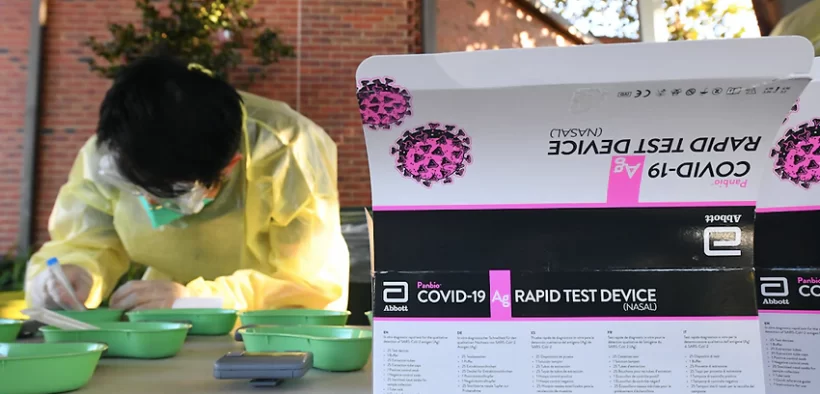Australians who test positive for COVID-19 through a rapid antigen test will soon be able to make a claim for the Pandemic Leave Disaster Payment.
The federal government announced in a statement on Saturday that from 10 January it would accept rapid antigen tests (RATs) as well as PCR tests from those who are seeking to claim the support payment.
Currently, $750 per seven-day period is available for those directed to self-isolate or quarantine, who are caring for someone with COVID-19, or meet the definition of a close contact, providing they are not earning income from work or certain other sources.
But from 18 January the payment will be scaled based on the number of hours of work an individual has lost or expects to lose over a seven-day isolation period.
Individuals who have lost or are expected to lose at least 20 hours of work will continue to be entitled to $750, while those who miss out on up to 19 hours of work will be able to claim $450.
The payment will not be available to people with available funds of $10,000 or more.
In order to claim the payment, an individual will need to show evidence of a positive RAT result from a testing clinic or health professional, or confirmation that they have registered a positive result from a home-administered test from their state health department.
Claims can be made up to 14 days from commencing isolation via MyGov, or by calling 180 22 66 if an individual does not have access to online services.
It comes as parts of the country are increasing reliance on RATs as the PCR testing network stretches beyond capacity.
RAT reporting mechanisms are already live in Victoria and Tasmania. In those states, people who test positive with a RAT need to personally notify health authorities, allowing their infection to be counted in official case tallies. After reporting a positive RAT, people will also become eligible to receive the support afforded to PCR-tested positive cases.
Other states look set to make similar moves in the near future.
It’s an evolving situation, but as of 7 January, here’s how each state and territory is using RATs.
Victoria
Victoria is now essentially treating positive RAT results the same as PCRs.
From Friday, anyone who receives a positive RAT is classified as a “probable” COVID-19 case and must isolate for seven days and notify their contacts. They’ll then receive the same clinical and financial support as PCR-confirmed cases.
“In the eyes of the health department, you have COVID,” acting chief health officer Ben Cowie said on Thursday of those receiving a positive result from a RAT.
The reporting hotline (1800 675 398) and online form are open, with more information available from the Victorian Government’s coronavirus reporting page.
Testing commander Jeroen Weimar says the hotline and form will check symptoms, whether people are a contact, the support they need, their vaccination status and pre-existing conditions.
He says it’ll allow for care to be provided faster, that the system has the capacity to deal with 50,000 reports a day, and that it can be stepped up if necessary.
Tasmania
The Tasmanian government has made the shift to RATs as the primary method for diagnosing COVID-19 cases.
Premier Peter Gutwein says people who test positive on a rapid test will be considered a case of COVID-19 and be subject to the same requirements as a positive PCR case.
People who return a positive RAT must register their result, after which they’ll be able to access care and financial assistance.
Tasmanians can register their positive RAT result on the government’s online form or call Public Health (1800 671 738). More information is available at the Tasmanian Government’s information for positive cases page.
Mr Gutwein said PCR tests will remain available for people who cannot access a RAT, cannot use one, are having trouble interpreting the result or have been clinically directed to have a PCR test.
What are the other jurisdictions doing?
NSW announced on Friday a reporting system through Service NSW allowing people to log their positive RAT would be set up next week.
“Currently we are working with our partners at Service NSW to establish a mechanism so you can actually register your positive RAT,” Chief Health Officer Kerry Chant told reporters. “And then we will change the orders so there’s a requirement to isolate as if you had a PCR-positive test and you get the same experience as if you did that.”
Dr Chant said people with symptoms who return a positive RAT result should treat themselves as a COVID-19 case. They should isolate for seven days and alert their close contacts, she said, and if a household contact or someone else with high-risk exposure returns a positive RAT, they should also consider themselves a COVID-19 case.
More information about rapid testing can be found at the NSW Health website, though it was yet to be updated to reflect Friday’s RAT announcement at the time of writing.
In the ACT, while it’s still recommended people confirm a positive RAT test result with a PCR result. Health Minister Rachel Stephen-Smith said on Thursday the government was working to set up a rapid test reporting mechanism. The latest rapid testing advice is available from ACT Health.
Queensland Premier Annastacia Palaszczuk said on Friday the state was in the process of setting up a RAT reporting hotline and on “a program that will be web-based in the not-too-distant future”. More information on rapid testing can be found at the Queensland Government’s website.
Western Australia announced on Wednesday it would lift its ban on the use of RATs next week. Guidelines around their use are yet to be detailed. The WA Government’s coronavirus information is available on its coronavirus webpage.
The Northern Territory and South Australia are yet to announce major changes to their rapid testing regimes. You can find the latest advice via the Northern Territory government and SA Health websites.
SBS With additional reporting by AAP.












